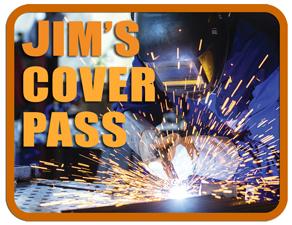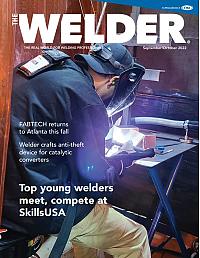Senior Company Trainer
- FMA
- The Fabricator
- FABTECH
- Canadian Metalworking
Categories
- Additive Manufacturing
- Aluminum Welding
- Arc Welding
- Assembly and Joining
- Automation and Robotics
- Bending and Forming
- Consumables
- Cutting and Weld Prep
- Electric Vehicles
- En Español
- Finishing
- Hydroforming
- Laser Cutting
- Laser Welding
- Machining
- Manufacturing Software
- Materials Handling
- Metals/Materials
- Oxyfuel Cutting
- Plasma Cutting
- Power Tools
- Punching and Other Holemaking
- Roll Forming
- Safety
- Sawing
- Shearing
- Shop Management
- Testing and Measuring
- Tube and Pipe Fabrication
- Tube and Pipe Production
- Waterjet Cutting
Industry Directory
Webcasts
Podcasts
FAB 40
Advertise
Subscribe
Account Login
Search
Jim's Cover Pass: A look back at a long welding career
Reflecting on what has changed over the years in the metal fabrication sector
- By Jim Mosman, AWS, CWI/CWE
- October 5, 2022
- Article
- Arc Welding
One of the interesting questions that I receive from a variety of sources is, “Over the course of your career, what do you feel is the biggest change or impact on the welding industry?”
I have to start off with the rationalization that I took my first welding class as part of a high school agricultural mechanics program in 1974. With the idea and goal primarily to fix broken farm equipment, we learned on Lincoln Electric AC Idealarc 225 power sources and used E6011 and E6013 electrodes. We also spent some time learning how to use the oxyacetylene torch to cut and weld. With three months of classes under my belt, I was a welder! Ironically, I have witnessed many young men and women over the years finish that first class, learn the same things, and believe and feel the same way I did. That new welder feeling hasn’t really changed.
My next experience with welding education began in 1981 and turned out to be the real start of my career. At the very mature age of 22 (I laughed when I wrote this!), I enrolled in a nine-month intensive welding program through the El Paso Trade School. This was after completing a four-year stint in the U.S. Army and with the financial assistance of the GI Bill. We were all issued a welding helmet with a Shade 10 lens to be used for everything. Safety glasses, earplugs, and even fume extraction systems were unheard of at the time. It was there that we were introduced to stick, MIG (they told us this was the new process), flux core, TIG, blueprint reading and layout, and even some pipe welding. Those were the names of the modules and that was the order in which we were taught. We now use different process acronyms, but many welding programs today still follow that same curriculum because “that is the way we have always done it.”
For the next 18 years, I found employment in the west Texas oil and gas industry, at both large and small manufacturing companies. For most of that time, the main process required in the industry was GMAW. Sure, I burned some rods and was able to increase my TIG skills with aluminum and stainless steel projects, but I ran an awful lot of wire over those years. I quickly realized that a strong work ethic and a decent amount of skill level would keep you working in a good economy or when things hit bottom. In the oil industry, that cycle changes on a regular basis, so I learned to save my earnings from 70-hour workweeks to keep food on the table when times were slow. Many young welders still have to learn that lesson the hard way.
On my 40th birthday, I accepted a welding instructor position at the local community college. Over the next 21 years, we experienced some of what I believe were the major changes in the welding industry. Advancements in inverter technology for welding and plasma cutting power sources led to major improvements in weld quality and economics. The pulse capabilities for GMAW and GTAW became increasingly required for employment. Most importantly, the quality and use of PPE increased dramatically over the last couple of decades. The autodarkening lens in your welding hood is now the norm, and you would not even think about walking into a welding facility today without safety glasses.
Next, we will look ahead at where the industry might be heading. To be continued …
About the Author

Jim Mosman, AWS, CWI/CWE
Lincoln Electric Education Division
About the Publication
subscribe now

The Welder, formerly known as Practical Welding Today, is a showcase of the real people who make the products we use and work with every day. This magazine has served the welding community in North America well for more than 20 years.
start your free subscription- Stay connected from anywhere

Easily access valuable industry resources now with full access to the digital edition of The Fabricator.

Easily access valuable industry resources now with full access to the digital edition of The Welder.

Easily access valuable industry resources now with full access to the digital edition of The Tube and Pipe Journal.
- Podcasting
- Podcast:
- The Fabricator Podcast
- Published:
- 04/16/2024
- Running Time:
- 63:29
In this episode of The Fabricator Podcast, Caleb Chamberlain, co-founder and CEO of OSH Cut, discusses his company’s...
- Industry Events
16th Annual Safety Conference
- April 30 - May 1, 2024
- Elgin,
Pipe and Tube Conference
- May 21 - 22, 2024
- Omaha, NE
World-Class Roll Forming Workshop
- June 5 - 6, 2024
- Louisville, KY
Advanced Laser Application Workshop
- June 25 - 27, 2024
- Novi, MI

































